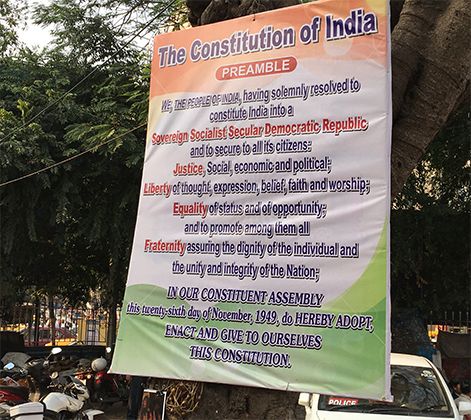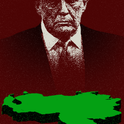At the annual Kolkata Book Fair, people flock from all over the city to browse millions of titles in Hindi, Bengali, Urdu, Sanskrit, and English. Islamic pop-up stalls sit alongside Hindu and Sikh neighbours. In an open clearing, a downsized Mount Rushmore-like statue towers over the crowds, made of ten faces clumsily fashioned from plastic and cloth. They include India’s most celebrated figures: Mother Theresa alongside revered author Rabindranath Tagore; in the centre, the independence activist Subhas Chandra Bose perches above the Hindu intellectual Swami Vivekananda. At the very top of the structure, Mahatma Gandhi is flanked by two printed slogans which have come to define India over the last two months: “No CAA.” “No NRC.”
For almost a year, these acronyms have been at the centre of a political storm around Indian citizenship and identity. In April 2019, Narendra Modi’s ruling Bharatiya Janata Party (BJP) unveiled its manifesto for the year’s general election. Under the heading “Combatting Infiltration” was a pledge to expand the National Register of Citizens (NRC) with the aim of cracking down on “illegal immigration.”
Furthermore, since the BJP’s re-election last May, Modi has also been planning to finalise a new National Population Register (NPR) to document all “usual residents.” Crucially, this latter roll will have access to Aadhaar — the world’s largest biometric database — which contains the details of 1.17 billion Indians (around 89 per cent of the total population.) Under Modi’s plans, “doubtful citizens” on the list may then be asked to prove their citizenship.
There have been mild justifications for the NPR and NRC—defenders say the registers will help support state modernisation, census-development, and national security. But as the Citizenship Amendment Act (CAA) passed in December 2019, the BJP’s conservative rationale has been rejected by many. The CAA grants amnesty to peoples of six religions who had entered India from Afghanistan, Bangladesh, or Pakistan before 2015, and who may not have the necessary documentation. Hindus, Sikhs, Christian, Buddhist, Jain, and Parsi settlers are effectively protected from the impending citizenship authentication process which the NRC and NPR enable. Muslims are not.

India’s 200 million Muslims make up the poorest religious community in India. Many cannot prove their place of birth, extending the risk of enforced statelessness to millions, irrespective of their migration status or country of origin. There are now fears that the government will use the registers and CAA to pursue mass incarceration, deportation, and violence towards India’s Muslims. The worry is that in Narendra Modi, India has a leader who not only has the potential to order Islamophobic violence, but also has a history of appeasing it. As chief minister of Gujarat in 2002, he did little to suppress anti-Muslim riots which killed over 1000 people. His decision in August 2019 to revoke the autonomy of Kashmir further showed him to be a decisive, dangerous actor. Writing in India Today, historian Joya Chatterji declared that “The CAA [has] turned India into an ethno-religious state.”
Like most Indian states, peaceful protests against the legislation are now being held across West Bengal, predominantly in its capital, Kolkata. “The people have taken this matter into their own hands,” says Kingshuk Chatterjee, history professor at Calcutta University. “The [protestors’] language of politics—the Indian flag and invoking the constitution—it resonates with the struggle against the British.” In his own students’ views, he also sees the influence of the Communist Party; in West Bengal, socialism and secularism often go hand in hand.
Indian nationalism was a powerful force in the run-up to the country’s independence in 1947, but for many Indians, Modi’s aggressive ideology—which prioritises Hindu purity over the foundational idea of a secular India—is repurposing history to justify a sinister fascism. Many do support the BJP’s programme, particularly in rural areas where anti-immigrant rhetoric finds favour and misinformation about Muslims spreads rapidly. There is a sense that the country’s core symbols are now being used by the BJP to reanimate centuries-old religious prejudices. Meanwhile in West Bengal, anti-CAA groups fly the Indian flag and invoke the nation’s greatest leaders to restore India’s inclusive history.
In Park Circus, a central neighbourhood of Kolkata, sit-in protests take place daily. Under a canopy, several hundred Muslim women sit and listen intently as a teenage girl brandishes the microphone, speaking forcefully in Hindi. “What Modi is doing; it is not the true India,” she declares. Around the edges of the crowd, placards honour those killed in violent clashes, particularly in Uttar Pradesh, a northern state where protests are escalating. One sign lists the six religious groups pardoned by the CAA but adds “Muslim” and “Atheist.” “A government that can’t understand India can’t hope to govern it,” reads the caption.

Specific to the protests in Kolkata is the prominence of Swami Vivekananda, a 19th century Hindu preacher born in the city in 1863, whose image accompanies anti-CAA slogans far more than any other figure. As a Hindu spiritual leader, Vivekananda’s status as an anti-CAA resistance symbol may seem contradictory. But in reality, he embodies the tolerant Hinduism—embraced in India as a spiritual framework rather than a devoutly followed religion—which has been subject to an alarming radicalisation by Modi and his allies. Indians of all faiths are pushing back and showing solidarity with their Muslim neighbours; diversity has been a key feature of the protests nationally.
In the face of Hindutva—the name given to Hindu extremism adopted by the BJP—the history of West Bengal encourages understanding between moderate Hindus and Muslims. “1947 is a poignant memory,” Chatterjee says. In the wake of Indian independence and the partition of Bengal into East Pakistan for Muslims (now Bangladesh) and West Bengal for Hindus, ensuing migrations led to thousands of deaths. Just a few years earlier in 1940, Maulana Azad—a Muslim politician and future education minister—declared himself “part of the indivisible unity that is Indian nationality.” But British mismanagement during the 1940s stoked factionalism between religious groups; chaos ensued. Though much has changed, 1947 takes on a new significance today as a parable of a distant, nationalist regime recasting India’s social fabric along religious lines already strained by generations of conflict.
At the Kolkata Book Fair, the relative calm was eventually disrupted. Towards the end of the festival last week, BJP national secretary Rahul Sinha arrived to visit a right-wing stall. Protestors and BJP supporters clashed, leading to six detentions. If Bengal’s history can offer warnings in the age of the CAA, then the speed and ferocity with which Hindu-Muslim relations can turn violent is the most important. “In India, we have a very impressionable political culture…” a woman who lived through partition tells me. Now, the strength of India’s historic national identity is being tested by its own leaders. It won’t be easily broken.












